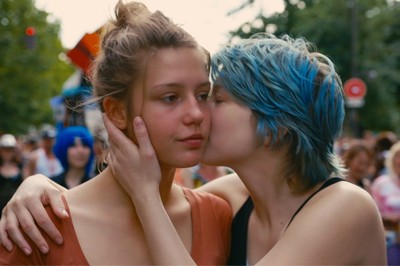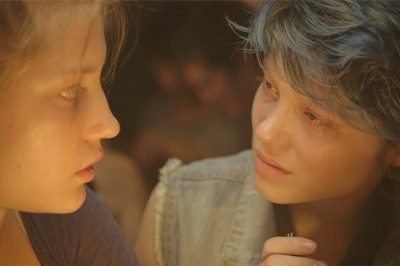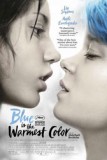| Reviews & Columns |
|
Reviews DVD TV on DVD Blu-ray 4K UHD International DVDs In Theaters Reviews by Studio Video Games Features Collector Series DVDs Easter Egg Database Interviews DVD Talk Radio Feature Articles Columns Anime Talk DVD Savant Horror DVDs The M.O.D. Squad Art House HD Talk Silent DVD
|
DVD Talk Forum |
|
|
| Resources |
|
DVD Price Search Customer Service #'s RCE Info Links |
|
Columns
|
|
|
Blue is the Warmest Color
IFC Films // NC-17 // October 25, 2013
List Price: Unknown [Buy now and save at Fandango]

Romantic flicks generally aren't my cup of tea. The majority of them blend together, making them become forgettable. However, it's difficult for most filmmakers to create a genuine love story within the running time of the average motion picture. It requires an incredibly large amount of convincing character development, a strong screenplay, engaging performances from its leads, and more. There are so many clichés in romantic dramas, that it can be easy to fall into them. After making its premiere at Cannes Film Festival in May, Blue is the Warmest Color quickly found itself in the conversations of many festival-goers due to its explicit sexuality. Writer/director Abdellatif Kechiche is known by many for his incredible feature The Secret of the Grain. Given his reputation for wonderful filmmaking, I was extremely excited to see how Kechiche would execute a love story originally based off of a graphic novel.
Adele (Adele Exarchopoulos) is a high school student who aspires to be a teacher. She loves working with children and devotes a lot of her time to reading and analyzing a variety of different texts. Her friends constantly pressure her to date guys, but she never seems very interested. After seeing a woman with blue hair (Lea Seydoux), she becomes infatuated with this mystery woman. Adele formally meets her in a lesbian bar and discovers that her name is Emma. She's an art student in college who has a strong passion for becoming better at her craft. They ultimately develop a strong relationship, despite the reactions of everybody around them. This is the story of their beginning, middle, and possible end.
Blue is the Warmest Color is alternatively called Adele: Chapters 1 & 2, since it has a considerable time jump. This break isn't noted, but it's surely present. Since the story takes place over a time frame of multiple years, it allows for the filmmakers to tell a complete story. However, this also allows for the potential opportunity of static moments. Fortunately, writers Abdellatif Kechiche and Ghalia Lacroix managed to avoid this problem. Not a single moment of the running time is wasted, as every frame is utilized to its fullest potential. Since this is a romantic drama, expect a lot of dialogue. There are a few monologues, but every sentence is raw and genuine. There's a lot of symbolism to be found throughout this screenplay. Even the smallest of details are huge bits of character disposition, so don't let anything slip under the radar. By the time the credits are rolling, you'll feel so close to Adele and Emma that they feel like real people. This hardly ever feels like a piece of fiction, since this level of true emotion is rarely ever shown in cinema.
The picture begins by following Adele in high school. Before it gets into the relationship that she has with Emma, it comes across as being your typical coming-of-age story. She forces herself to be in a relationship with a guy, but it's clear that Adele isn't able to connect with him on an emotional level. After she encounters love at first sight with Emma, they start spending a lot of time together as friends. However, there's a clear sexual tension between the two. Adele's friends saw her walking with Emma, so they accuse her of being a lesbian. At first this came across as being a tired story element, but it acts as something entirely different. Adele constantly puts up a brick wall in front of anybody that tries to get close to her. Instead of this acting as a dramatic plot point, it introduces this aspect of her personality. As the relationship between Adele and Emma continues to flourish, their conversations get more intense. Regardless, their dialogue held my full attention.
The most crucial hint to enjoying Blue is the Warmest Color is to have patience. Writer/director Kechiche takes his time when building his characters. Most of these movies are two hours, at the very longest. However, this romantic drama hits the three-hour mark, which might keep some viewers away. If you're looking to watch a beautiful love story unfold, then don't let the running time scare you off. It doesn't feel as long as it actually is, as it kept me captivated throughout. Fortunately, my mind didn't wander a single time, due to the wonderfully-written characters. The next reason that one might not watch this is for the explicit sexual content. While I wasn't bothered by it, this is a piece of the film worth informing potential audiences. Blue is the Warmest Color earned its NC-17 rating with its sex sequences, but these acts are performed under a great amount of passion. By the time the running time is over, you'll feel like you just went through an exhausting relationship yourself. However, there aren't very many filmmakers who have been able to achieve such a great feat within this genre.
Chemistry in romantic dramas can make or break the entire motion picture, regardless of how fantastic the screenplay is. Adele Exarchopoulos is absolutely phenomenal in the role of Adele. She hasn't been in many pictures, but this is a performance worthy of an expert. Not only does she represent this character in a perfect way, but she pulls even the most subtle of details out of this role. Lea Seyoux is an excellent choice to work as Emma. They have some of the strongest chemistry that one would expect to see on the screen. Seydoux is very convincing as this young artist with a dream. The supporting roles are powerful, as well. However, Exarchopoulos and Seydoux are clearly the stars here. These are performances worthy of Academy Awards.
Kechiche is just as particular with his visual design as he is with the remainder of his picture. The cinematography is utterly fantastic, as it portrays the passionate relationship we see on screen. The blue tone of Emma's hair stands out very clearly in each and every scene that she's in. The camera angles are very specific, as the majority of the movie is captured from medium shots. However, Kechiche's sparing use of long shots are very strong when utilized, since they're so uncommon in this picture. The rhythmic flow of the visuals in this drama are very particular, yet very impactful.
It may be extremely long, but writer/director Abdellatif Kechiche's newest feature is outstanding. There aren't very many romantic dramas that are able to captivate audiences in the same way that this one does. The writing is great, the acting is impeccable, and the visuals are wonderful. This French film is truly a piece of art that deserves to be seen by audiences around the world. It's a powerful piece of filmmaking that is rare to find with its use of compelling characters and engaging plot developments. This genuinely doesn't feel like a movie, but more like a window into this young woman's life. Adele describes this film perfectly within her own dialogue regarding literature in the film. She states that she dislikes when her teachers analyze the meanings behind the texts, as it takes all of the imagination and wonder out of the stories. Blue is the Warmest Color requires patience and it doesn't let its viewers off easy, but the pay-off is grand. This is certainly a worthy addition to our DVD Talk Collector Series.

|
| Popular Reviews |
| Sponsored Links |
|
|
| Sponsored Links |
|
|
| Release List | Reviews | Shop | Newsletter | Forum | DVD Giveaways | Blu-Ray | Advertise |
|
Copyright 2024 DVDTalk.com All Rights Reserved. Legal Info, Privacy Policy, Terms of Use,
Manage Preferences,
Your Privacy Choices | |||||||










